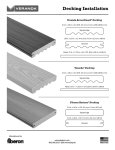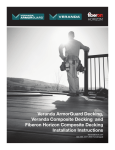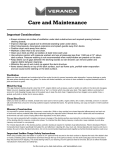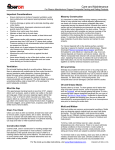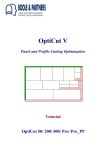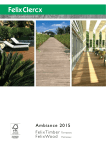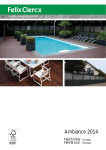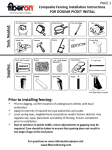Download Fiberon BRDPRTF CN 20-10PK Installation Guide
Transcript
Fiberon® Decking Installation Instructions Getting Started Follow local approved building codes. Careful planning of the finished deck layout will result in better looking finished projects. Failure to follow installation guidelines could void warranty. • Joist location plays an important role in the safety of the deck itself but may also affect the ease, method and price of your railing system. • Before starting, read the instructions of both the decking and railing systems planned for the project. • Dark colors will absorb more heat than lighter colors and as such, will experience greater ranges in expansion/contraction. • Thoroughly reading all instructions first will make for more profitable projects. Failure to do so may result in more difficult installation and may void warranty. • For decks using metal joisting, specialized surface fasteners are required. Do not use Phantom Hidden Fasteners or Deck Pilot fasteners. Fasteners for metal that install at a 90 degree angle only are required. Joist Spacing 3 Blocking Stringers or Joists When installing blocking for more intricate decking patterns, remember that solid blocking (blocking laid on the flat) will inhibit water flow and result in buildup of organic materials over time, which will make cleaning more difficult. For best results when blocking is required, it should be installed ladder style (Figure 3). Board Spacing Joists used in deck frame construction should be 2"x 8" (5 cm x 20 cm) or larger (Figure 3). Joist/Stringer Spacing Residential When installing heavy loads on top of your decking project, a hot tub, for example, it is important to also understand the requirements of the manufacturer as they may have specific framing and support requirements for their warranty coverage. Commercial Brand Perpendicular Diagonal Stairs Perpendicular Diagonal Stairs Paramount 16 12 16* 12 8 12* Horizon 16 12 12 12 8 9 Sanctuary 16 12 12 12 8 9 ProTect Advantage 16 12 11 12 8 9 Good Life 16 12 11 12 8 9 Classic 16 12 9 12 8 9 Docking 24 12 12 N/A N/A N/A All decking materials, whether wood, composite or metal, undergo some degree of linear expansion with the changes of weather and the season. To compensate for the effects of contraction and expansion, the following installation standards must be maintained: End Gapping 5 WALL Determined by Temperature Determined by Temperature 4 * Secure stair treads over and in contact with a treated pine 2x6, installed flat, not on edge, as under support, and secured with Simpson A23 approved connectors and 10d x 1-1/2" hot galvanized nails. Residential Joist Spacing 1 Joists Deck Boards 16" o.c. (41 cm) 3 2 Joists Deck Boards 12" o.c. (31 cm) Side-To-Side Spacing LEDGER JOISTS/BlOCKING Note: Special consideration should be taken when working with dark colors as they will experience larger temperature swings during normal use. To help control end-to-end spacing, dark color decking should be kept at ambient temperature and shaded from direct sun prior to cutting and immediate securing. The following procedures will result in less visible gapping: • Keep boards out of direct sun during storage and cutting processes, and through to installation if possible. Never cut and install boards in direct sun assuming them to be at ambient temperature. • Use lighter colored boards in the field of the deck with darker colored boards as design accents. For the most up-to-date instructions, visit fiberondecking.com. Fiberon® Decking Installation Instructions • Use short boards where possible. • Use splitter/divider boards between each continuous run of boards. • Surface fasten using heavy gauge (#9 or #10) quality composite deck screws. Do Not Toe-Nail Proper Installation 7 8 1-1/2" (4 cm) 90-Degrees Gapping: Deck Board End-To-End Spacing by Temperature Deck Board Deck Brand 35˚ & Under 36˚ - 69˚ 70˚ - 89˚ 90˚ - 109˚ 110˚ & Up Paramount 1/16" 1/32" 1/32" 0 0 Horizon 1/4" 3/16" 1/8" 1/16" 1/32" Sanctuary 1/4" 3/16" 1/8" 1/16" 1/32" ProTect Advantage 1/4" 3/16" 1/8" 1/16" 1/32" GoodLife 1/4" 3/16" 1/8" 1/16" 1/32" Classic 1/4" 3/16" 1/8" 1/16" 1/32" Docking 1/4" 3/16" 1/8" 1/16" 1/32" Note: For locations with extreme temperture swings, double-joisting and surface fastening may be required to minimize shifting of material. Adhering to these spacing parameters will: • Promote proper drainage and ventilation • Aid in the removal of organic debris • Meet board spacing requirements for Fiberon warranty coverage Surface Fasteners The use of stainless steel composite deck screws is strongly recommended. Composite surface fasteners may be used - check with manufacturer for coating warranty. Pre-drilling is recommended. Plain, galvanized surface fasteners are not recommended. Fastener Setback 1-1/2" (4 cm) Setback Deck Board #1 Deck Board #2 6 Added Joist/ Blocking Screw heads must be flush with board surface. Use caution to avoid over-tightening fasteners. Excess tightening may cause immediate or eventual cracking of the fastener locations. Do not surface fasten within 11/2" (4 cm) of the end of a board or 1" (3 cm) from the side of the board. Deck Deck Deck Board Board Joist Joist Joist/ Blocking Joist/ Blocking Pre-drilling • It is necessary to pre-drill end of board screw holes to prevent immediate or eventual end splitting (Figure 6). • Pre-drilling all holes will result in better looking finished projects. DO NOT over-tighten fasteners. Over-tightening will induce cracking at board ends. • Surface fasteners should always be driven in at a 90˚ angle to the decking surface. Toe-nailing screws is not recommended (Figure 7). Instead, the placement of blocking/sister joists, when needed, is recommended to allow perpendicular installation of surface fasteners at board ends (Figure 8). • Pre-drilling is required in cold temperatures. Requirements • Clean, straight lines of fasteners look better than wobbly lines. Use white chalk, straight boards or string lines as templates for straight lines. • All brands of Fiberon decking may be surface fastened. Annular thread, ring shank and spiral shank nails, of sufficient length, have excellent holding power and produce good results. • Screws have superior holding power. Use only screws designed for composite decking. DO NOT USE traditional bugle-head screws. • For a cleaner look, stainless steel composite screws are recommended. These screws are engineered specifically to work with composite decking and prevent mushrooming, resulting in better looking finished projects. Fastening Boards Fiberon decking requires two fasteners at every joist location (Figure 9). While surface fastening is allowed on all Fiberon decking products, the use of FIberon branded Phantom Hidden Fasteners are highly recommended with Fiberon grooved (GV) decking to create a smooth, unblemished, decking surface. Fiberon GV boards cannot be used as stair treads. 9 For the most up-to-date instructions, visit fiberondecking.com. 4 Fiberon® Decking Installation Instructions Hidden Fasteners FASTENERS RECOMMENDED FOR USE WITH FIBERON GV DECKING include Phantom Hidden Fasteners and Phantom End Clip Hidden Fasteners. Fiberon Paramount square edge decking requires the use of Fiberon Cortex Screws, the only approved hidden face fasteners recommended for Paramount decking. Fiberon Cortex screws are available in all five colors of Paramount Decking. Wood Grain Patterns Note that the wood grain patterns on Fiberon decking are directional. Different looks can be achieved by laying the decking in the same or alternating directions. There are several different wood grain patterns. See Figure 10 below for one of these patterns. 10 Ventilation Do not install decking directly to a solid surface. Make sure there is adequate and unobstructed air flow under the deck to prevent excessive water absorption. Improve drainage or grade flat areas where standing water may gather. Allow a minimum of 6" (15 cm) between the bottom of the deck substructure/joists and the ground. The deck design must allow unrestricted airflow under at least 50% of its perimeter to permit adequate ventilation. Fascia Installation Fascia is intended as a non-structural covering for rim joists, risers and stringers. Screws should be installed at a maximum 12" (30 cm) interval, with three screws across the face at each interval (Figure 12). For Paramount, also apply a zigzag bead of high quality exterior adhesive to the entire length of the back (smooth side) of the board, within 2" (5 cm) of the edges and ends. Do not over-tighten screws as buckling and cracking may result. Install with 1/8" (3 mm) spacing between the edges and ends in temperatures above 50˚ F (10˚ C). Leave 3/16" (5 mm) space between edges and ends in temperatures below 50˚ F (10˚ C). 12 Proper Fascia Installation The graining pattern repeats approximately every 44" (1.12 m) feet along the board length. To ensure you orient the boards to achieve the desired effect, a directional label is noted on the side of each board showing grain direction. During the planning phase of any deck project, arrange decking before installation to achieve the desired pattern and color effect (Figure 11). This is also important if different lengths/bundles of material are used as different wood grain patterns and color tones may need to be mixed to achieve the desired look. 11 Wood Grain Orientation During Installation 12" Fire and Unusual Heat Sources Composite decking will retain heat when exposed to direct or reflective sunlight. Exercise caution if walking barefoot as footwear may be required. Fire and unusual sources of heat and heat buildup can potentially damage Fiberon decking surfaces. Examples would include fire, reflected light from different types of glass (ex. low-e glass), fire features and under-deck waterproofing installations that do not provide the 6" (15 cm) of un-obstructed net free ventilation. • Low-E Glass/Reflected Heat Low-emissivity glass is designed to prevent heat gain inside the house by reflecting sunlight outward. This reflective property can result in excessive heat buildup on the surface of Fiberon decking and on exterior surfaces. Same Direction 5 Alternating Direction When the sunlight is reflected and concentrated it can harm a range of building materials that include doors, windows, siding, trim and decking. Damage caused to For the most up-to-date instructions, visit fiberondecking.com. Fiberon® Decking Installation Instructions these products can include melting, sagging, warping, discoloration, increased expansion and contraction and accelerated weathering. If you have questions on how to reduce this risk, contact the manufacturer of the product which contains the Low-E glass for suggestions on how to reduce or eliminate the reflected heat. • Under-deck waterproofing systems Under-deck waterproofing systems, properly installed, can provide additional living or storage space. Improper installations are those that restrict air flow and result in buildup of heat and/or humidity which can result in unwanted consequences. Important Ladder Usage Safety Instructions When using a ladder on composite decking, it is mandatory to lay down a sheet of plywood over the deck surface to disperse the load of the ladder’s feet to nearby underlying joists. Drill fasteners downward through the top of the plywood sheet to keep it from slipping. Position fasteners so they adequately protrude and rest firmly in the gaps between the deck boards and into the joists. This will avoid leaving holes in your decking once the plywood sheet is removed. Be sure to always follow the ladder manufacturer’s instructions and safety tips. Contact the manufacturer of the specific under-deck waterproofing system for installation instructions to ensure required 6" (15 cm) of un-obstructived net-free ventilation is achieved for Fiberon decking. If already installed, seek methods to achieve the ventilation requirement. • Fire Features/Fire Pits Fire features and fire pits are increasingly popular in outdoor living environments. Fire can damage many building products including Fiberon decking. Improperly installed fire features and fire pits can cause damage to the surface of Fiberon decking via direct exposure to the flame or excessive radiated heat. Proper caution should be taken when designing, installing and using these features to ensure damage does not result. Static Dry or windy environments may create a temporary condition of static electricity, which will vary depending on climate and site conditions. In the case of excessive static buildup on an installed PVC or HDPE capped deck, Fiberon recommends to use the following procedure: 1.Remove loose debris from the deck surface. 2.Dilute ACL Staticide® Concentrate 1 part to 39 parts water (1:39). 3.Spray or mop entire surface of the deck. 4.Allow to air dry - do not attempt to wipe the surface dry as wiping will reduce the effectiveness of the antistatic coating (*Although very safe in diluted form, ACL Staticide® Concentrate is considered a hazardous chemical non-diluted. DO NOT use ACL Staticide® Concentrate non-diluted.) For the most up-to-date instructions, visit fiberondecking.com. FIB-0098-LIT 3/14 6




